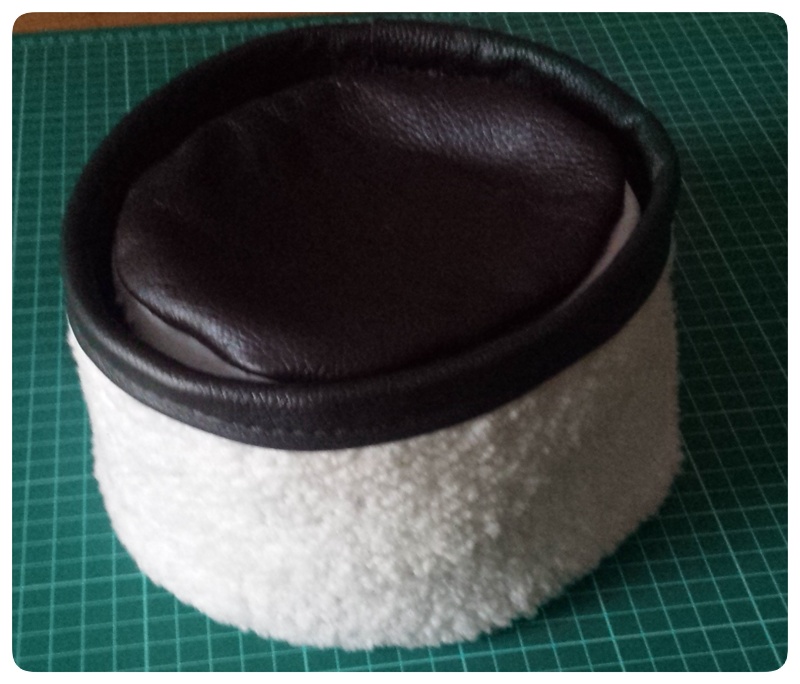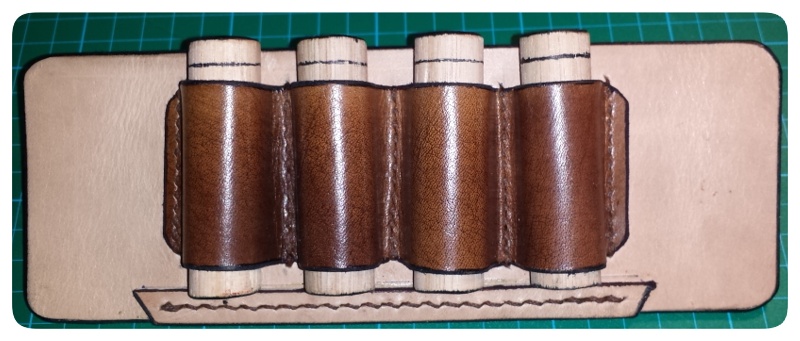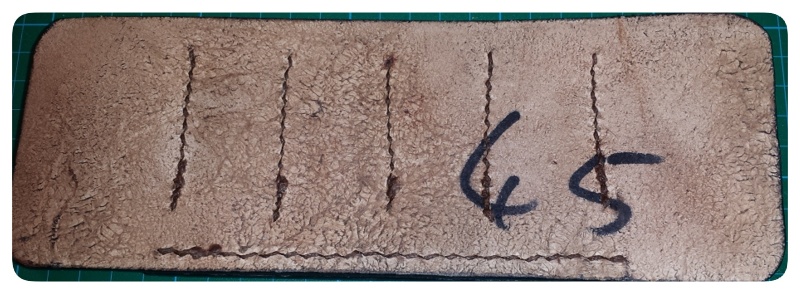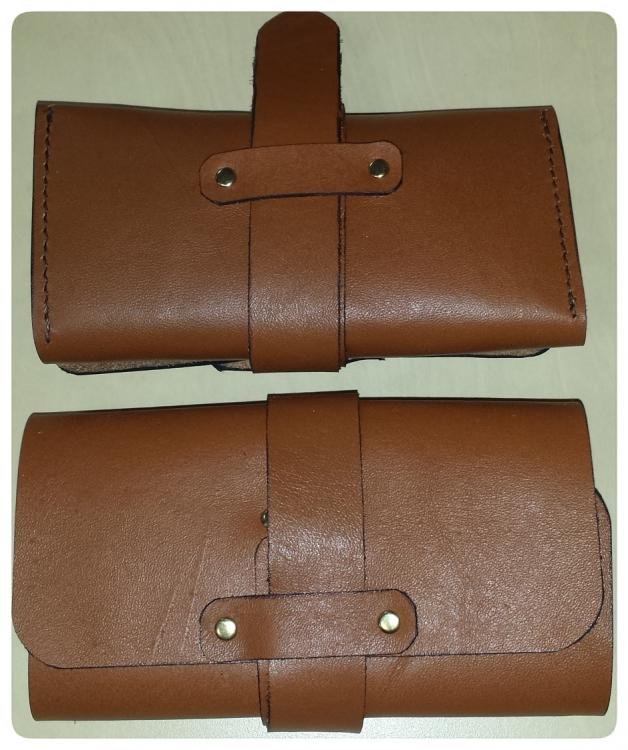-
Posts
262 -
Joined
-
Last visited
Content Type
Profiles
Forums
Events
Blogs
Gallery
Everything posted by Riem
-
Old post, but wow! You learn something new on leatherworker.net every day! Pure beeswax! I presume it would be treated in some way or another to 'stabilise' it?
-
Thanks for the confirmation Yin. It's just that I think that stuff like my learner projects should be put up with a sign saying "hard hat required - learning in progress" or something like that. And thanks for appreciating my hat! Thank you Blink! Yeah, it is indeed. However the wool seems to cause a skin irritation. I've washed it with a non allergenic softener but I still seem to have a reaction to the wool. Will do a quick fix cotton lining to see if it solves the issue. If not, someone will receive an unexpected gift...
-
Is there a forum other than "Show off" where one can post something that you know is not show quality, flawed in one or many ways, but you still want to say, "Hey, I'm doing something, OK!"? Like, "Every cockerell thinks it's chick is going to be an eagle some day, but it still has to scratch for a worm today"... (Old proverb, that.) So since it's winter here and I need a warm woolly hat, I decided to make one. There are no beavers readily available so I couldn't beg a skin off of one and had to stick to sheepskin shearling. Don't think it's fully done yet. I still want to work on a few "features"... Here's the inside. Proof it was stitched by hand
-
- 4 comments
-
- crocodile
- cross body bag
-
(and 1 more)
Tagged with:
-

Questions - Shotgun cartridge belt
Riem replied to stormdevil's topic in Gun Holsters, Rifle Slings and Knife Sheathes
He needs the belt mainly for clay pigeon shooting, where speed is definitely an issue so the requirement for the shells to ride high is there. I've had a look at a few commercially available belts from both a local manufacturer and of Chinese import. Both were advertised as "action shooting" belts and both had the stop strip below the loops. Even though it will be a lot of stitching I think I'll add the strip. -

Questions - Shotgun cartridge belt
Riem replied to stormdevil's topic in Gun Holsters, Rifle Slings and Knife Sheathes
Friend is also a bit of a leather aficionado, and has stated his preference for an "all leather" shell belt. I do have webbing available but he'll be disappointed and probably not use the belt. Besides, I'd like to give it a go with leather. -

Things I've Learned From Leather Working
Riem replied to CTaylorJr's topic in Leatherwork Conversation
I know this is an old thread (circa 2014) but This.Is.Priceless! -

Questions - Shotgun cartridge belt
Riem replied to stormdevil's topic in Gun Holsters, Rifle Slings and Knife Sheathes
Although I'm not particularly keen on adding the strip I'm concerned about the loops stretching over time. The calfskin I'll be using for the loops is rather soft and I think there's a possibility that the cartridges will fit loosely after some use. Perhaps the stop strip is more for my own sense of comfort than for actual mitigation of the risk of a cartridge dropping through... BTW, the stamping on the loops really makes it pop - lovely! I'm going to test a few of the stamps I have to see if there's any that I can use on this strap... -

Questions - Shotgun cartridge belt
Riem replied to stormdevil's topic in Gun Holsters, Rifle Slings and Knife Sheathes
I'm still a bit undecided about the lining - maybe dye as you suggested. Even if I don't dye, I'll apply some sort of acrylic (since it's a gift, the recipient won't have too much say about the final look! ) which will also stiffen it a bit. I'm no stranger to hand stitching, it's all I know. Attached is a picture of a carry strap I've completed recently, from the same hide as I'll cut the belt. This one was vinegarooned and also hand stitched. -
Thanks, appreciate you saying that, @immiketoo Learning and knowledge management are just some of the areas where I've spent a big part of my career. I'm still new here, and hope I'm not adding such academic stuff that is boring and scares others away. I've learnt such a lot from the participants on leatherworker.net that if I can add something that is of benefit to others, I will gladly do so. I should have added that we humans seem to have a preference - hardwired or acquired - of learning through stories. We'd sit for countless moments listening to (and even participating in) the stories our 'elders' tell of how they solved problems or survived hardship or how they came out on top of some challenge. This is actually part of what I've learnt of as the "Primal Learning" cycle. Back at the dawn of time, how did the early humans master the harsh conditions without modern conveniences? While we will never know with exactness, perhaps something like the following was involved. At night, they'd be around the clan's campfire in whatever shelter they'd be taking refuge in, natural family groups would while away time by listening to the war stories of elders. The stories were likely more than factual with rich embellishments and villains and hero roles inserted that emphasised and idealised productive behaviours. "That mammoth with the sore leg that we killed two moons ago? Let me tell you how I found him!"... and out would come a tale about central roles and how to actions and leadership and whatnot. The campfire turned into the school where youngsters and inexperienced members of the clan would both be informed and inspired. From the campfire they returned to the cave to rest and reflect. Reflection is perhaps the single most undervalued part of the learning process. In their reflection they would assimilate new information into what they already know. "Big Hairy said he could get within range of the mammoth when the wind was blowing in his face and not on his back. You know, when I tried to get close to that buck I was stalking last time, the wind was in my back. Maybe that's why the buck got away". From the cave, the novice or youngster took his insights to the watering hole where he shared them with his friends. He got confirmation of his ideas and insights, i.e. he transferred the knowledge into a social setting to mobilise it into action. In essence, he socialised new ideas/knowledge with peers and gained support, legitimising action. This part is usually not a linear process - it may take long to gain acceptance, with many a return to the cave of reflection, until action is primed. New knowledge has to be tested in the real world, so our ancestor and mates likely had to actively seek out opportunities in the veld to put their 'theories' into practice. If they were unsuccessful, it likely meant a return to the watering hole and the cave of reflection to refine their theory and amend it by adding further insights. It might have taken a trip back to the campfire - the school - to ask questions to enrich their learning. Until they had success in real life - a slain animal to contribute to the clan's upkeep. And also a new story to tell around the campfire. If we pause a moment to ask "what type / category of threads on leatherworker.net did each of us learn the most from during the last year, I bet a fair number of people would cite topics such as "show your workbench or workspace" and "how did you get into leather work" and such less formal topics. Perhaps precisely because of the human stories that shone through in those topics... Sorry for another long ramble...
-

Questions - Shotgun cartridge belt
Riem replied to stormdevil's topic in Gun Holsters, Rifle Slings and Knife Sheathes
Full belt. I'm not skilled enough at stamping and tooling to do much embellishment though. -

Questions - Shotgun cartridge belt
Riem replied to stormdevil's topic in Gun Holsters, Rifle Slings and Knife Sheathes
Fabulous information in this thread, thank you! I've been asked by a friend to make him a shotgun shell belt for clay pigeon shooting. Below is the prototype I've come up with from scraps and leftovers from previous projects. Edges coloured with a sharpie, and burnished with saddle soap (yeah, on a prototype, but I want friend to sign off on the design... ) I've gone the route of hand stitching the loops, as I don't have the punches needed for the slots, and cutting it instead of punching would have been a recipe for disaster. Belt will be 4 mm vegtan, 80 mm wide, with 10 mm "stop strip" stitched 7 mm below the loops. Loops will be cut from 1.4 - 1.6 mm calfskin vegtan, 50 mm wide. And here is the back (unlined, of course). Stitching looks a bit wonky, and that vague glimmer of red? 100% natural, biodegradable dye pumping through my veins... Still enough of it left to allow me to type this posting! I'm still undecided about lining it at the back - what would you recommend? I'd be interested in reasoning other than esthetics - I'd love to line with calfskin, but haven't got enough of the length to laminate the back. -
Very interesting conversation indeed! As an ex-corporate trainer and instructional designer I've spent countless hours studying and observing what true competence is about and how it is constructed. Yes, you need knowledge (acquired through "studies" or distilled from experience) and you need experience (the much talked about 10,000 hours of immersive experience) but there are two additional factors that need to be in play: aptitude and inspiration. Without aptitude - the inherent ability to manipulate the tools of the trade - you will not achieve true competence. Someone who has the proverbial ten thumbs can acquire the knowledge of hand stitching, but the skill of using an awl or threading a needle may be a bridge too far. Similarly there has to be inspiration (which is frequently incorrectly labeled as either 'motivation' or as 'attitude'). The spark that kindles the fire. The spark arises either within or arrives from external sources. When it arrives it has to hit the tinder of knowledge, prior relevant experience and aptitude at just the right moment in the right conditions before it will lead to action. Learning and acquisition of skill is a messy affair. It does not come in neat packages. It is stochastic and not always goal directed - we frequently 'file away' an experience and extract the learning from it months or even years later. If there was a simple, single way to learn, we'd stand the danger of becoming interchangeable units of labour who are required to execute without passion. Interesting indeed... Enough from me tonight
-

WIP wide belt
Riem replied to spacedog's topic in Purses, Wallets, Belts and Miscellaneous Pocket Items
Joh, joh... Incredible detail! You say you don't have much experience doing stuff like this? Well, you clearly have an abundance of talent to ride on until 'experience' comes along... No need to "fake it until you make it". Congratulations - well done! -
Thanks for the welcome, Handstitched. I'm Riem, not 'emo chair', although I've hijacked his intro thread to announce myself. I presume your customer is ex-Kimberley, now living in Australia? Else sending stuff all the way over there and back will be quite an expensive endeavour. I also have a brother who lives in Australia - City of Newcastle. Who knows, I may one day make the trek that way. And that 'yah man'? Another Saffer signature phrase, but the Afrikaans will be 'ja man'! The 'ja' translates as 'yes' so the phrase is then 'yes man' - but there is a depth of nuances in that phrase...
-
Joh, that's war talk! But you still get a taste of it now and then, I hope? Biltong is surely a fine food wherever it is encountered, let's just not call it jerkey... Similar but quite different. When did you leave Zim, Alisdair? I've encountered many ex-Zim people in my life. Even the tannery I use (oasistanning.co.za) was established by an ex-Zim family.
-
Yes, "velle" is indeed skins, but not just Springbok skin - even a bovine hide or a human skin is a 'vel', with "velle" then the plural. Comes from 17th century shipboard Dutch "vellen" if I'm not mistaken. However, a tanned and softened vel used as a blanket (usually hair on) is not just a vel - it's a "karos" or even a "velkaros"... And a springbokvel is a thing of beauty!
-
Thanks for the kind offer of assistance, Bob. Appreciate it. Yes, the Afrikaans for skins is "velle" (singular = "vel"). And the Afrikaans for leather is "leer" which is interestingly enough the same word we use for 'learning'. My handle - Riem - can loosely be translated as "rawhide rope" although a proper riem is not made from rawhide at all. I still don't know how to translate the Afrikaans term "brei into English... KK
-
Thanks for the welcome, BDAZ! Well, that "howzit" says it all... I've read many of your postings and have never suspected a South African background. Good to make your acquaintance. Quite cold in Jozi today - predicted max @ 14°C today. I've taken a day off work today and want to start on an ammo belt for a friend's shotgun shells - he does clay pigeon shooting. He recently gave me a fresh Gemsbok (Oryx) skin... That's at a tannery being turned intoa vegtan hair-on skin at the moment. I'll receive it back in about four months. Still have not decided what to make from it. Cape Town had a hard time with drought the last few years, so the rain is truly heaven sent. Doubt it will solve their problem this season since the it aquifers are also depleted and will take a couple of years to fill. But at least they can start showering again!
-
Hi everyone, Seems us Saffers introduce ourselves by saying where we're from, eh? So I'm in Johannesburg, North-western side of the city, although I make the daily trek to the Jozi city centre to earn a living - and so I can afford leather, tools, dye, stamps, thread... Yeah, right. I'm not completely new to working with leather - it's crossed my path a few times over the last 50 years or so - although I have started actively making stuff about 18 months ago. I learnt a basic saddle stitch from Oupa (Grandpa) as a young laaitie but discovered that I've been doing it either badly or just plain wrong from two sources: leatherworker.net (a.k.a. Leather School, IMHO) and from Mr Bloch of P Bloch & Co. I've joined leatherworker.net sometime last year, and have grown immensely as a hopeful hobbyist leather crafter (or is that "crufter"? ) from reading postings on here. year last yleatherworker.net last year I've made dozens of smaller and bigger items over the last year or so, including a man bag, tool rolls, a handbag or two, a laptop bag, etc. Also restored a few items for friends, family and colleagues. Below is an image of two of four tool roll style cellphone charger/cable pouches delivered to a work colleague this morning. Made from 1mm thick, pre-dyed Italian "upper" leather and brass tubular rivets, and what little stitching there are on these was done by hand using John James harness needles and acrylic upholstery thread (I think about 0.5 mm, mid-brown).

.jpg.d60258221c476480a6e073a8805645bb.jpg)





